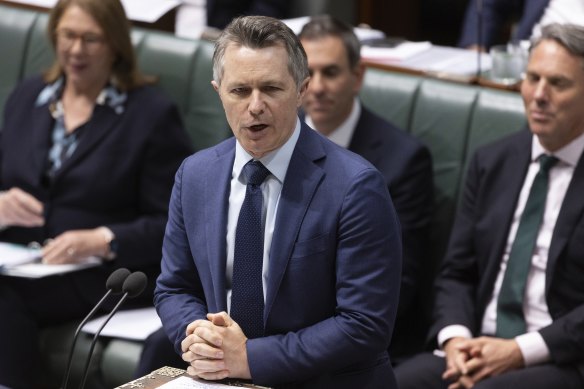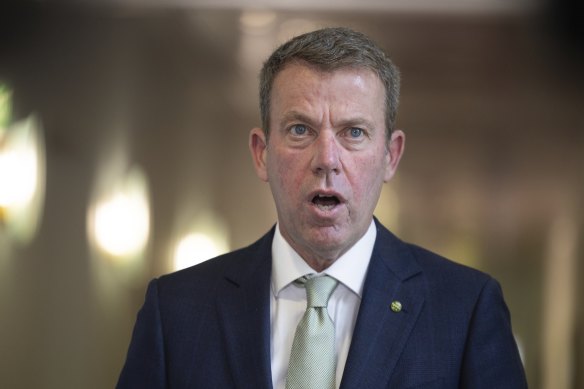New foreign students capped at 270,000 in blow for large universities
By Natassia Chrysanthos and Daniella White
Big city universities and private colleges have been told to slash their international student intake as Education Minister Jason Clare seeks to limit the number of foreigners starting their studies in Australia next year to 270,000.
The cap, revealed on Tuesday, means about 53,000 fewer new overseas students will be accepted in 2025 compared to 2023, a 16 per cent cut, as the federal government responds to political pressure to reduce overall migration numbers.

Education Minister Jason Clare refused to detail each institution’s cap.Credit: Alex Ellinghausen
Clare rejected claims the foreign student cap would undermine Australia’s $48 billion higher education sector and argued it would instead level the playing field by directing more international students to regional and smaller universities while returning enrolments to pre-pandemic levels.
The vocational education sector will be hit the hardest, with a cap of about 95,000 new students next year representing 40,000 fewer enrolments than in 2023. Private universities will be limited to 30,500 new students, a 28 per cent cut.
Publicly funded universities will be allowed 145,000 new overseas student enrolments, just 1 per cent below 2023 levels.
But the brunt of cuts will be borne by prominent institutions that have dominated the international student market, including the University of Sydney, the University of Melbourne, UNSW, Monash University and the Australian National University.
Sources familiar with their enrolment data but unwilling to speak publicly said top universities would have to cut new foreign student enrolments by 26 per cent, based on early calculations.
Clare refused to detail each institution’s cap and the big universities did not provide the figures when contacted on Tuesday.
But several sources with knowledge of the policy said the government had given universities a formula for reducing numbers, based on how much their international student populations had grown since before the pandemic.
Universities with the highest concentration of international students, who represent more than 37 per cent of the student population, will have to shed half their growth in new foreign student numbers since 2019.
This will have the largest impact on the University of Sydney, where almost 50 per cent of students are from overseas and international student enrolments have grown 41 per cent since 2018.
At the other end of the scale, universities where fewer than 15 per cent of students are from overseas will be allowed to keep all their growth in foreign student enrolments since 2019.
In practice, it means the big metropolitan universities, which have attracted predominantly Chinese students, will have to cut their enrolments. But smaller and regional universities, which have more students from South and South-East Asia, will be able to boost their numbers.
The University of Newcastle’s numbers will rise from 1565 in 2023 to a cap of 1600 in 2025, for example, while Charles Darwin University will be able to enrol 2200 foreign students next year, compared to 2100 last year.
Clare will also abolish the unpopular Ministerial Direction 107, which Labor introduced last year to slow down visa processing and identify non-genuine students. In practice, it has meant fewer students from countries such as India, Nepal and Pakistan have been approved for visas and regional universities have lost enrolments.
Clare spruiked the reforms on Tuesday as a way of making the sector fairer.
“For some, it will be less. For some, it will be more. The big winners are regional universities. It’s designed to make sure we set up the system in a better and fairer way, in a more sustainable way,” he said.
“To create the impression that this is somehow tearing down international education is absolutely and fundamentally wrong.”
‘The idea that a Chinese student who wants to go to the University of Sydney will instead go to Southern Cross University is unrealistic.’
Higher education expert Professor Andrew Norton
But higher education expert Professor Andrew Norton said he did not buy the argument that the caps would redistribute students from city universities to the regions.
“The whole idea that a Chinese student who wants to go to the University of Sydney will instead go to Southern Cross University is completely unrealistic. They simply won’t come to Australia,” he said.
“That’s because these students are very focused on prestige, and only the Group of Eight have enough prestige. They also want to live in cities where they have plenty of their fellow compatriots and shops and restaurants that make coming to Australia much less of a culture shock than it would be in a regional town.”
He also said there would be risk in executing the caps. Universities would either end up making conservative offers, and end up with fewer students than they could have, or send too many offers and be forced to cancel some of them.
“If it gets to the point where we’re cancelling enrolments, this could well turn into a diplomatic incident for the source counties and give Australia a very bad reputation,” he said.
Group of Eight chief executive Vicki Thomson said the government had not provided any economic modelling on the impact of the caps.
“This policy was bad yesterday and it is bad today – the unexplained number gives us no comfort,” she said.
“What has changed is the government today trying to steamroll the sector into accepting detailed caps before a clearly sceptical Senate has passed judgment on the ill-conceived legislation that enables these enrolment limits.”

Shadow immigration minister Dan Tehan says this is a mess of Labor’s own making.Credit: Alex Ellinghausen
The Independent Tertiary Education Council, which represents private universities and training colleges, said it had sought urgent clarification from the government about the announcement because its members were not given a specific institution-level cap.
Correspondence seen by this masthead suggested colleges with fewer than 80 per cent foreign student enrolments would be able to maintain their enrolment levels, but those with a higher concentration would have to slash numbers.
Universities have become a focus of Labor’s plans to halve net migration from 520,000 in 2023 to 260,000 by June next year and fend off an election fought over immigration.
Coalition immigration spokesperson Dan Tehan and education spokeswoman Sarah Henderson said they welcomed student caps but hit out at Labor’s handling of foreign student numbers, which have risen in this term of government.
“This mismanagement of one of our most important exports is a mess of Labor’s own making and it’s taken far too long for Labor to wake up,” he said.
Cut through the noise of federal politics with news, views and expert analysis. Subscribers can sign up to our weekly Inside Politics newsletter.